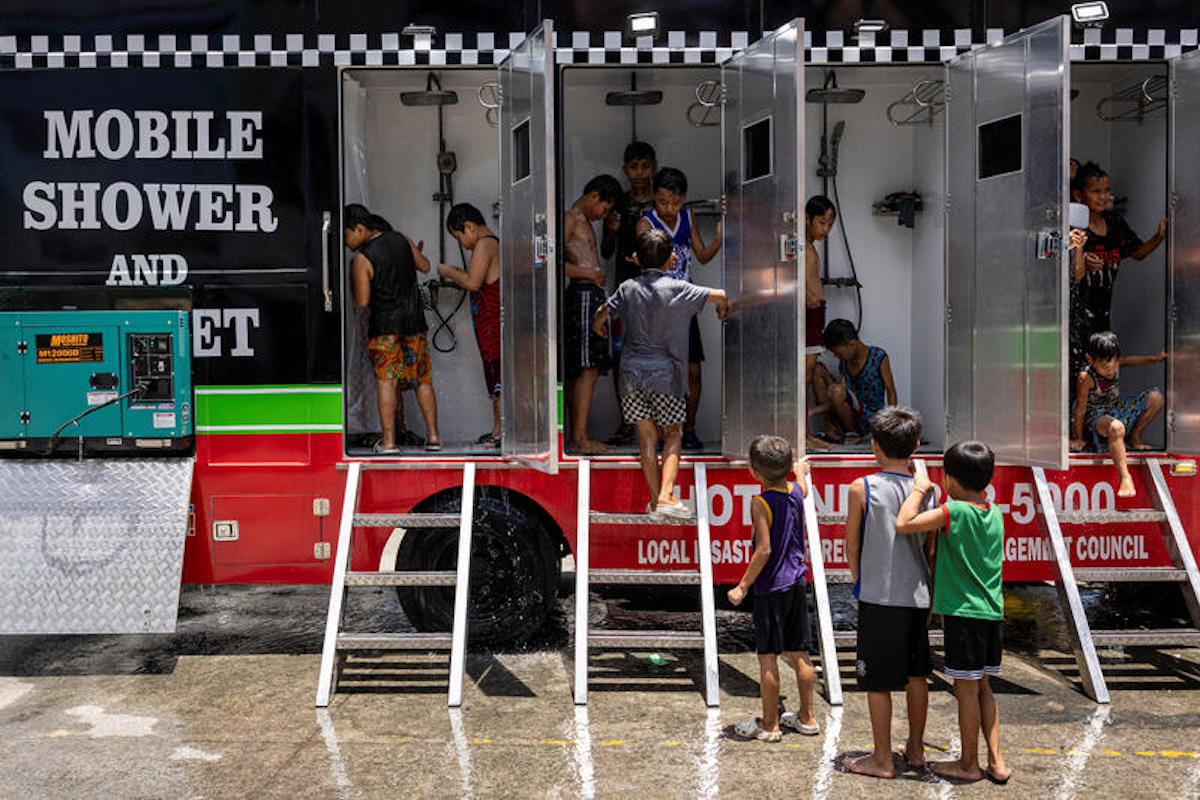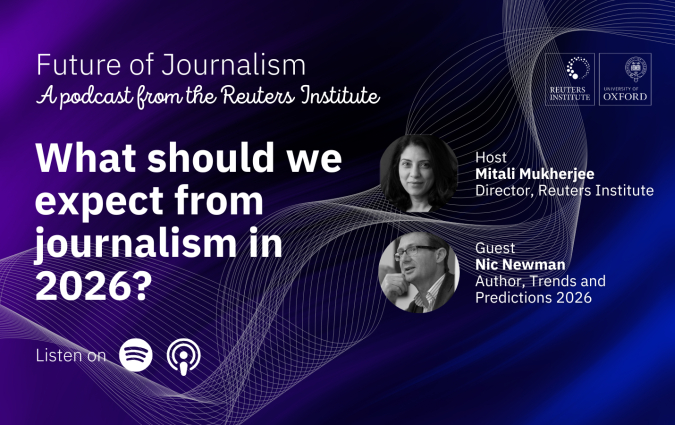Seven lessons for journalism in the age of extreme heat

Children use a mobile shower provided by the local government, amid extreme heat in Valenzuela, Metro Manila, Philippines in May 2024. REUTERS/Eloísa López
Extreme heat is harming our societies. From children forced to stay away from school and agricultural workers struggling out in the field, to increased demand for electricity and health services, countries are not set up to deal with extreme heat in a warming world.
These impacts are now arriving with a regularity that should concern us all. In many parts of the world, extreme heat has its own season. For many months of the year, our systems are pushed and stretched.
Policymakers know this and have started creating plans to deal with the health implications of extreme heat. We are beginning to see hospitals stocking up, cities setting up cooling centres and communities deploying early warning systems.
For journalists and newsrooms, this regular rhythm of extreme heat means that we can also prepare our coverage, in the same way we plan the coverage of elections, Olympic Games or the awards season.
This idea – that extreme heat is something we should learn about and prepare for – was at the heart of our 2024 Oxford Climate Journalism Network Annual Event: Journalism in the Age of Extreme Heat. This online conference was hosted on 1 and 2 May with our OCJN community, including alumni, members, and partners.
Over six hours of programming, OCJN members past and present gathered to hear from experts and other journalists. It was a space to think about the many dimensions of extreme heat but also about how to report under demanding conditions that impact the mental and physical welfare of journalists themselves. This is some of what we learned:
1. Extreme heat as a ‘silent killer’
Extreme heat kills thousands every year, and it’s the deadliest extreme weather event. But reporting on extreme heat presents a challenge when it comes to creative storytelling. Put simply, heat events are more difficult to convey visually than other extreme weather events, such as flooding caused by storms or devastating wildfires.
"We often don’t see the effects of extreme heat until months later,” said our keynote speaker, Dr. Eleni "Lenio" Myrivili, Global Heat Officer at Atlantic Council and UN Habitat. “Heatwaves are left out [in coverage],” she said. “They're not visual, and are hard to access even narratively.”
It’s often difficult to know how many deaths a heatwave caused until months or a year later, she said, because deaths linked to extreme heat tend to be recorded as kidney failure, heart attacks or other illnesses. Tracking excess deaths during a heatwave can give a fuller picture. For instance, during the European heatwave in the summer of 2022, nearly 63,000 people are estimated to have died.
So what does this mean for journalists? Firstly, we must prepare for the heat. It starts with having basic literacy in the newsroom to truly understand its impacts. A good option is reviewing guides that specialist organisations have prepared on how to report on heat, including the Global Heat Health Information Network and World Weather Attribution (available in 12 languages).
Secondly, we must go to the places and speak to the people affected to bring the story to life. While ‘heat’ itself is invisible, its effect on humans is not. The stories of extreme heat can be told from homes, health centres and hospitals, but these impacts also extend into almost every other aspect of society. Extreme heat coverage isn’t just for the meteorology desk. It’s part of all beats and desks.
Finally, we should not think the story has ended when the heat subsides. We must go beyond the breaking story and towards the impacts – and solutions – that follow high temperatures. A key place to discuss heat is urban coverage, said Surella Segú, former Chief Heat Offer for the city of Monterrey, Mexico.
“We need to act now,” she said. “We are passing the time of talking about resilience. We need to talk about the regeneration of our cities – how to bring nature massively to our cities.”
2. Health is where we see heat’s impact first
When it comes to the impacts of heat, the impact on our own health is often the most immediate symptom of the danger. But even the healthcare community is often unprepared to recognise the links between heat, climate, and health.
Egyptian physician and academic Dr. Omnia el Omrani spoke about her experience of working in an Egyptian hospital, and how many physicians are still coming to recognise the influence of extreme heat on the human body.
“We are not trained to think about heat stress,” she stated. “There's a lack of preparedness as physicians, either at the emergency department or amongst GPs.”
Dr. el Omrani also spoke about what she identified as “the hidden gap” – the influence of extreme heat on the mental health of patients and caregivers. She offered an example about how some doctors have altered levels of prescription medication because of the way the human body responds under extreme heat.
She also noted the correlation between rising heat and infectious diseases, including malaria and dengue. “We need early warning systems in our health care facilities.”
Ana Bottallo, assistant health editor with the newspaper Folha de S. Paulo in Brazil, talked about the importance of reinforcing the connections between extreme heat, climate change and health for the publication’s audiences.
“We’re talking about something which has an effect on our nature and ecosystems but also on our health,” she said. “Let’s not treat heatwaves as something extraordinary, or as something we don’t have anything to do with.”
Extreme weather events such as heat should not only be covered by the metro desks during an emergency, she argued, but also in collaboration with specialised reporters in health and environment.
3. Planning, planning, planning
The bad news: extreme heat events are here to stay. The slightly better news: just as cities can prepare with heat action plans, newsrooms can do the same.
Myrivili, from UN Habitat, talked about a three-step approach her home city of Athens, Greece took: they raised awareness, then prepared with tools and data, and then redesigned the city and how it’s used. A similar method (awareness, preparedness and redesign) can be applied to newsrooms.
For European outlets, the record-breaking heat of summer of 2022 was a key turning point to raise awareness. The following year, France Télévisions started to put resources into their preparations.
“For a whole year, starting from the summer of 2022 we had an inside transformation,” says Audrey Cerdan, climate editor at the broadcaster. “When we arrived in April 2023, we had a meeting to prepare for the summer, with IPCC scientists.” The upcoming Paris Olympics, held in July and August 2024, will take place mid-summer, so they’re preparing again.
Ben Rich, lead weather presenter at the BBC, said the newsroom learned a lot from their experience broadcasting about the 40º C temperatures experienced in the UK in 2022. "By the time I got to work I was already exhausted,” he said.
As an outlet with many platforms (national and local, digital and linear) Rich spoke about the huge appetite from colleagues and audiences for the story, but also about the physical and emotional toll of his reporting.
Lilys Njeru, a member of OCJN cohort 5 and health and a science reporter at The Nation, Kenya, spoke about the dynamics of storytelling in a country where heat is the norm. Often, the concern was that extreme temperatures are not dropping at night-time, which previously provided some respite, she pointed out.
As we plan, we can take lessons from how policy makers and heat experts are adapting cities, companies and communities. “The key thing with any action plan is how localised it is,” said Aditya Valiathan Pillai, an adaptation expert and a fellow at Sustainable Futures Collaborative, during our event. “Heat is very different based on the location,” he said. “It can vary from street to street. Heat action plans have this burden of trying to see who is going to be impacted.”
For us journalists, that means that a heat reporting plan will be different in Rio de Janeiro and in Paris. For every newsroom and every country, that approach on how to report on extreme heat will look different.
4. We can draw lessons from COVID-19 coverage
There are many parallels to be drawn between COVID-19 and how we respond to extreme heat events.
The first is preparedness. Do governments, cities and communities have an action plan and know what to do when it happens? And if they do, are those plans successfully communicated to citizens? And what is the role of journalism before, during and after these events? These are significant questions, with powerful consequences.
As we saw during COVID-19, in extreme heat events there are stories of human tragedy, but also stories of heart-warming action and solidarity.
“Heat can affect social cohesion,” said Dr. el Omrani. “It’s also affecting the mental health of children and young people because they simply can’t go outside. There’s an impact on development and building relationships.”
Again, like COVID-19, extreme heat events disproportionately affect the most vulnerable in our societies. They’re often those who don’t have access to safe cooling. Their voices, stories and experiences are invaluable to authentic reporting.
5. As always, human stories are key
Eight years ago, Amy Steel was still a professional netball player in Australia. While playing at an outdoor stadium on a 40º C day, she had a heat stroke and barely survived. She was rushed to the hospital and spent nine months in a dark room recovering. Steel still lives with the health effects of her experience.
“I was an elite athlete. I’ve gone from being the fittest in the team, to [not being able to] get my own groceries [when it’s too hot],” she said. Now retired due to the health impacts of heat stroke, Steel speaks about what sports organisers and athletes need to consider in a warming world.
“What happened to me was entirely preventable,” she told our annual event. “This could have so easily have not happened had I been more aware of it. If people are more aware, they might make better decisions than I did.”
Voices like hers are essential to the heat story. Whether it’s tea workers in Bangladesh or delivery drivers in Asunción, the people affected should be leading our stories – and we should listen to their reflections and solutions.
The ripple effect of heat also means that those stories can encompass all kinds of events and cross nearly every beat.
“Most of the recommendations [on dealing with heat] come from public health and clinical background. But now we’re finding that it’s impacting agriculture, electricity, sports events, election and political cycles,” said Pillai, the adaptation expert. “Everything has to take heat into account”.
6. Planning includes making sure we stay safe
The impacts of extreme heat affect all of us – even journalists. While outlets have long had risk assessments, training and planning in place when reporting from war zones or terror incidents, little preparation has been done around media professionals covering extreme heat. That preparation needs to be more serious than packing a hat and sunscreen.
“My colleague and I were travelling in 35º C plus heat for the past three days for a story,” said Nhung Nguyen, a member of OCJN cohort 5 and a freelancer in Vietnam. “Our rental motorbike’s tires broke four times as the road was too hot, and I almost fainted once.”
We heard from Dipanita Nath, a reporter for the Indian Express who just last month suffered a heat stroke as she covered a story near the Mula-Mutha river, in Maharashtra. “When we go out into the frontline of climate change, it takes a toll on us physically –and emotionally, but that's another story),” she said.
In preparing for our annual event, we found that newsroom safety guidelines for reporting during extreme heat were almost unheard of. And yet members and partners told us about simple steps that can help: not shooting or reporting at certain times of day, for example, reporting for shorter periods with more breaks, or even at night.
Lou Albano, GMA News Online managing editor in Manila and an OCJN alumna, spoke at the event while the country was undergoing an extreme heat event. “I work at a TV network,” she said. “Right now, there are so many night scenes on local TV because it’s simply too hot to be filming during daytime.”
Increasingly, we hear that cameras, batteries and other electronic equipment overheat and don’t work for long periods when heat is extreme. This can make reporting more difficult or time consuming, and it can also pose a safety risk if journalists’ phones or equipment become unreliable.
7. Extreme heat will continue to shape what we do
“Heat is an everywhere problem. It’s an every-sector-of-the-economy problem,” said Pillai, who works on heat action plans in India.
This opens an opportunity for reporters at every desk to approach heat as an angle. How should travel reporters think about it? What about those covering open-air music and sporting events? And photojournalists chasing a perfect image? How much attention to give heat in the education beat? And what about editors planning election coverage?
Quite literally, any person in the newsroom now has a direct relationship with heat. As former athlete Steel put it: “For this to start happening to elite athletes makes it so very real that it can happen to everyone. This is touching all sides of society; it doesn’t matter your socio-economic status or your existing health. Based on your very humanity, you’re increasingly vulnerable to this.”
In every email we send you'll find original reporting, evidence-based insights, online seminars and readings curated from 100s of sources - all in 5 minutes.
- Twice a week
- More than 20,000 people receive it
- Unsubscribe any time
signup block
In every email we send you'll find original reporting, evidence-based insights, online seminars and readings curated from 100s of sources - all in 5 minutes.
- Twice a week
- More than 20,000 people receive it
- Unsubscribe any time







